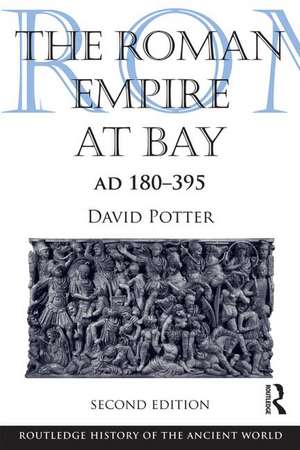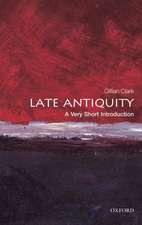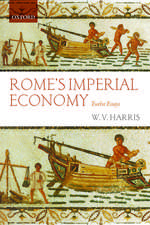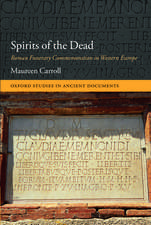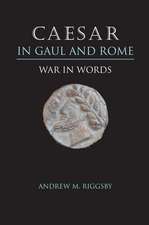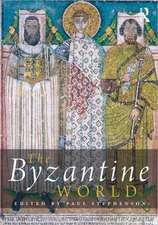The Roman Empire at Bay, AD 180-395: The Routledge History of the Ancient World
Autor David Potteren Limba Engleză Paperback – 24 dec 2013
| Toate formatele și edițiile | Preț | Express |
|---|---|---|
| Paperback (1) | 350.43 lei 6-8 săpt. | |
| Taylor & Francis – 24 dec 2013 | 350.43 lei 6-8 săpt. | |
| Hardback (1) | 1109.99 lei 6-8 săpt. | |
| Taylor & Francis – 12 dec 2013 | 1109.99 lei 6-8 săpt. |
Preț: 350.43 lei
Nou
67.05€ • 73.07$ • 56.50£
Carte tipărită la comandă
Livrare economică 23 aprilie-07 mai
Specificații
ISBN-10: 0415840554
Pagini: 792
Ilustrații: black & white illustrations
Dimensiuni: 156 x 234 x 36 mm
Greutate: 1.29 kg
Ediția:Revizuită
Editura: Taylor & Francis
Colecția Routledge
Seria The Routledge History of the Ancient World
Locul publicării:Oxford, United Kingdom
Cuprins
Part I: The shape of Rome 1. Culture, economy and power 2. Economy Part II: Reshaping the old order 3. Crises in government 4. The army in politics; lawyers in government 5. Intellectual trends in the early third century Part III: The Roman Empire and its neighbours, 225-99 6. The failure of the Severan empire 7. The emergence of a new order Part IV: The Constantinian Empire 8. Alternative narratives: Manichaeans, Christians, and Neoplatonists 9. Rewritings of the Tetrarchy: 300-13 10. Restructuring the state: 313-37 11. Constructing Christianity in an Imperial context Part V: Losing power 12. Church and State:337-55 13. The struggle for control: 355-66 14. The end of hegemony: 367-95
Recenzii
“An invaluable new edition for students who seek a rich narrative and penetrating analysis of two centuries that starkly reshaped the fortunes and mindset of everyone within the empire’s orbit.” – Richard J. A. Talbert, University of North Carolina at Chapel Hill, USA.
“A rich and multifaceted study by a world-leading scholar in the period, The Roman Empire at Bay portrays the transformations and continuities of the Empire and its government in the third and fourth centuries from an exciting variety of perspectives, and abounds in bold, sometimes contestable, but always stimulating interpretations. Potter’s book is the best textbook on the high and late Roman empire, above all because it is so much more than a textbook.” – Gavin Kelly, University of Edinburgh, UK.
"Potter's political and military narrative remains masterful. The account of events and issues confronting the empire after the death of Marcus Aurelius is dramatic and convincing. Confusing military actions and dynastic maneuverings leading to the rise of Theodosius are sensibly untangled. Attention should be drawn anew to Potter's discussion of the historiography of the (broadly defined) Constantinian era and his finely nuanced chapter, "Intellectual Trends in the Early Third Century. Summing Up: Highly recommended." -P.B. Harvey Jr., Pennsylvania State Univeristy, USA in CHOICE
"…Potter’s unified history of this tumultuous period remains the best available."-David Neal Greenwood, University of Edinburgh, UK in Bryn Mawr Classical Review
Notă biografică
David Potter is Francis W Kelsey Collegiate Professor of Greek and Roman History and Arthur F. Thurnau Professor of Greek and Latin at the University of Michigan.
Descriere
The Roman Empire at Bay is the only one volume history of the critical years 180-395 AD, which saw the transformation of the Roman Empire from a unitary state centred on Rome, into a new polity with two capitals and a new religion—Christianity. The book integrates social and intellectual history into the narrative, looking to explore the relationship between contingent events and deeper structure. It also covers an amazingly dramatic narrative from the civil wars after the death of Commodus through the conversion of Constantine to the arrival of the Goths in the Roman Empire, setting in motion the final collapse of the western empire.
The new edition takes account of important new scholarship in questions of Roman identity, on economy and society as well as work on the age of Constantine, which has advanced significantly in the last decade, while recent archaeological and art historical work is more fully drawn into the narrative than it was in the past. At its core, the central question that drives The Roman Empire at Bay remains, what did it mean to be a Roman and how did that meaning change as the empire changed? Updated for a new generation of students, this book remains a crucial tool in the study of this period.
